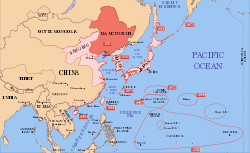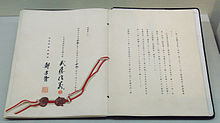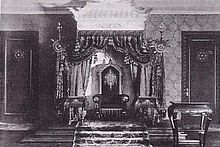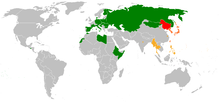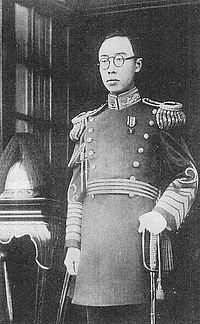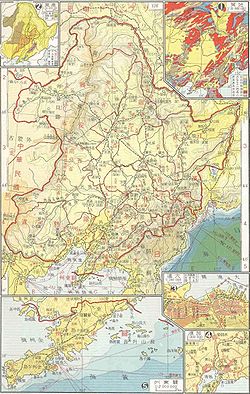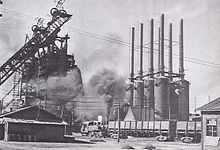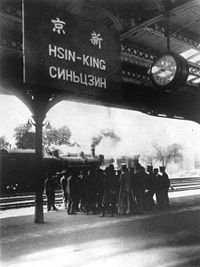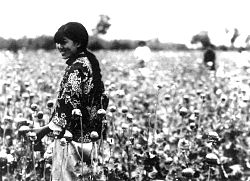- Manchukuo
-
Manchu State
(1932–1934)
(Great) Empire of Manchuria
(1934–1945)
滿洲國 / 满洲国(Chinese)
Mǎnzhōuguó
満洲国 (Japanese)
Manshū-koku
(1932–1934)
(大)滿洲帝國 / (大)满洲帝国(Chinese)
(Dà) Mǎnzhōu Dìguó
(大)満洲帝国 (Japanese)
(Dai) Manshū Teikoku
(1934–1945)Puppet state of Japan ← 
1932–1945  →
→

Flag Imperial Seal Anthem
National Anthem of Manchukuo (de jure)
Kimigayo (de facto)Location of Manchukuo (Red) within the Japanese sphere (Pink) Capital Hsinking Language(s) Japanese (by officials, forced learning), Mandarin Chinese (de facto), Mongolian, Manchu (discouraged) Religion Shinto, Buddhism, Taoism Government Constitutional Monarchy
(Puppet state)Chief Executive / Emperor - 1932–1934 Puyi Aisin-Gioro (era name: 'Tatong') - 1934–1945 Puyi Aisin-Gioro (as Emperor Kangte) Prime Minister - 1932–1935 Zheng Xiaoxu - 1935–1945 Zhang Jinghui Legislature Legislative Council Historical era World War II - Established 1932 - Disestablished 1945 Currency Manchukuo yuan Manchukuo Chinese name Traditional Chinese 滿洲國 Simplified Chinese 满洲国 Literal meaning Manchu State Transcriptions Gan - Romanization Mon3 jiu1 goet6 Mandarin - Hanyu Pinyin Mǎnzhōuguó - Wade–Giles Man-chou-kuo - IPA [màntʂóʊkwɔ̌] Cantonese (Yue) - Jyutping mun5 zau1 gwok³ - IPA [mʊ̬ntsɐ́ukʷɔ̄ːk] Japanese name Kanji 満州国 Kana まんしゅうこく Transcriptions - Romaji Manshū-koku Empire of Manchuria Chinese name Traditional Chinese 大滿洲帝國 Simplified Chinese 大满洲帝国 Transcriptions Mandarin - Hanyu Pinyin Dà Mǎnzhōu Dìguó - Wade–Giles Ta Man-chou Ti-kuo - IPA [tɑ̂ màntʂóʊ tɨ̂kwɔ̌] Cantonese (Yue) - Jyutping daai6 mun5 zau1 dai³ gwok³ - IPA [dɐ̀.mʊ̬ntsɐ́u.tɐ̄ikʷɔ̄ːk] Japanese name Kanji 大満州帝国 Kana だいまんしゅうていこく Transcriptions - Romaji Dai Manshū Teikoku Manchukuo (simplified Chinese: 满洲国; traditional Chinese: 滿洲國, lit. Manchu state) or Manshū-koku (Japanese: 満州国) was a puppet state in Manchuria and eastern Inner Mongolia, governed under a form of constitutional monarchy. The region was the historical homeland of the Manchus, who founded the Qing Empire in China. In 1931, the region was seized by Japan following the Mukden Incident and in 1932, a sympathetic government was established, with Puyi, the last Qing emperor, installed as the nominal regent and emperor.[1] Manchukuo's government was abolished in 1945 after the defeat of Imperial Japan at the end of World War II. The territories formally claimed by the puppet state were first seized in the Soviet invasion of Manchuria in August 1945,[2] and then formally transferred to Chinese administration in the following year.[3]
Manchus formed a minority in Manchukuo, whose largest ethnic group were Han Chinese. There were also Koreans, Japanese, Mongols, White Russians and less numerous minorities. The Mongol regions of western Manchukuo were ruled under a slightly different system in acknowledgement of the Mongolian traditions there. The southern part of the Liaodong Peninsula was ruled by Japan as the Kwantung Leased Territory.
Contents
History
Background
After Manchu tribes conquered China they replaced the Ming Dynasty with the Qing. However, the Manchu emperors did not fully integrate their homeland into China. This legal and, to a degree, ethnic division continued until the Qing dynasty began to fall apart in the 19th century.
During its reign the Qing Dynasty became highly integrated with Chinese culture. The dynasty reached its height in the 18th century, during which both territory and population were increased. However, its military power weakened thereafter and, faced with massive rebellions and defeat in wars, the Qing Dynasty declined after the mid-19th century.
As the power of the court in Beijing weakened, many outlying areas either broke free (like Kashgar) or fell under the control of Imperialist powers. In the 19th century, Imperial Russia was most interested in the northern lands of the Qing Empire. In 1858, Russia gained control over a huge tract of land called Outer Manchuria thanks to the Supplementary Treaty of Beijing that ended the Second Opium War. But Russia was not satisfied and, as the Qing Dynasty continued to weaken, they made further efforts to take control of the rest of Manchuria. Inner Manchuria came under strong Russian influence in the 1890s with the building of the Chinese Eastern Railway through Harbin to Vladivostok.
Origins
See also: Mukden IncidentAs a direct result of the Russo-Japanese War (1904/05) Japanese influence replaced Russia's in Inner Manchuria. In 1906, Japan laid the South Manchurian Railway to Port Arthur (Japanese: Ryojun). Between World War I and World War II Manchuria became a political and military battleground between Russia, Japan, and China. Japan moved into Outer Manchuria as a result of the chaos following the Russian Revolution of 1917. A combination of Soviet military successes and American economic pressure forced the Japanese to withdraw from the area, however, and Outer Manchuria returned to Soviet control by 1925.
During the warlord period in China, the warlord Zhang Zuolin established himself in Inner Manchuria with Japanese backing. Later, the Japanese Kwantung Army found him too independent, so he was assassinated in 1928.
After the Japanese invasion of Manchuria in 1931, Japanese militarists moved forward to separate the region from Chinese control and to create a Japanese-aligned puppet state. To create an air of legitimacy, the last Emperor of China, Pu-Yi, was invited to come with his followers and act as the head of state for Manchuria. One of his faithful companions was Zheng Xiaoxu, a Qing reformist and loyalist.[4]
On 18 February 1932 the Manchu State (Manchukuo, Pinyin: Mǎnzhōuguó)[5] was proclaimed and recognized by Japan on 15 September 1932 through the Japan-Manchukuo Protocol. The city of Changchun, renamed Hsingking (Pinyin: Xinjing) (新京, literally "New Capital"), became the capital of the new entity. Chinese in Manchuria organized volunteer armies to oppose the Japanese and the new state required a war lasting several years to appease the country.
The Japanese initially installed Puyi as Head of State in 1932, and two years later he was declared Emperor of Manchukuo with the era name of Kangde ("Tranquility and Virtue"; Wade-Giles: Kangte). Manchukuo thus became the Great Manchurian Empire, sometimes termed Manchutikuo (Pinyin: Mǎnzhōu Dìguó). Zheng Xiaoxu served as Manchukuo's first prime minister until 1935, when Zhang Jinghui succeeded him. Puyi was nothing more than a figurehead and real authority rested in the hands of the Japanese military officials. An imperial palace was particularly built for the emperor. All of the Manchu ministers served as front-men for their Japanese vice-ministers, who made all decisions.
In this manner, Japan formally detached Manchukuo from China in the course of the 1930s. With Japanese investment and rich natural resources, the area became an industrial powerhouse.
In 1935, Manchukuo bought the Chinese Eastern Railway from the Soviet Union.
Diplomatic recognition
China did not recognize Manchukuo but the two countries established official ties for trade, communications and transportation. In 1933, the League of Nations adopted the Lytton Report, declaring that Manchuria remained rightfully part of China, leading Japan to resign its membership. The Manchukuo case persuaded the United States to articulate the so-called Stimson Doctrine, under which international recognition was withheld from changes in the international system created by force of arms.
In spite of the League of Nations' approach, the new state was diplomatically recognised by El Salvador (3 March 1934) and the Dominican Republic (1934), the Soviet Union (de facto 23 March 1935; de jure 13 April 1941),[6][7] Italy (29 November 1937), Francoist Spain (2 December 1937), Germany (12 May 1938) and Hungary (9 January 1939).
It is commonly believed that the Holy See established diplomatic relations with Manchukuo in 1934. In fact, the Holy See never did so. This is partly due to the erroneous reference in Bernardo Bertolucci's 1987 film The Last Emperor, that the Holy See diplomatically recognised Manchukuo. Bishop Auguste Ernest Pierre Gaspais was appointed as "representative ad tempus of the Holy See and of the Catholic missions of Manchukuo to the government of Manchukuo" by the Congregation De Propaganda Fide [a purely religious body responsible for missions] and not by the Secretariat of State responsible for diplomatic relations with states.
After the outbreak of World War II, the state was recognised by Slovakia (1 June 1940), France (12 July 1940), Romania (1 December 1940), Bulgaria (10 May 1941), Finland (18 July 1941), Denmark (August 1941), Croatia (2 August 1941)—all controlled or influenced by Japan's ally Germany—as well as by the China's Wang Jingwei government (30 November 1940), Thailand (5 August 1941) and the Philippines (1943)—all under Japanese control.
Puyi as Emperor Kangde of Manchukuo
World War II and aftermath
Before World War II, the Japanese colonized Manchukuo and used it as a base from which to invade China. In the summer of 1939 a border dispute between Manchukuo and the Mongolian People's Republic resulted in the Battle of Khalkhin Gol. During this battle, a combined Soviet-Mongolian force defeated the Japanese Kwantung Army (Kantōgun) supported by limited Manchukuoan forces.
On 8 August 1945, the Soviet Union declared war on Japan, in accordance with the agreement at the Yalta Conference, and invaded Manchukuo from outer Manchuria and Outer Mongolia. This was called Manchurian Strategic Offensive Operation. During the Soviet offensive the Army of Manchukuo, on paper a 200,000-man force, performed poorly and whole units surrendered to the Soviets without firing a single shot; there were even cases of armed riots and mutinies against the Japanese forces. Emperor Kangde had hoped to escape to Japan to surrender to the Americans, but the Soviets captured him and eventually extradited him to the communist government in China, where the authorities had him imprisoned as a war criminal along with all other captured Manchukuo officials.
From 1945 to 1948, Manchuria (Inner Manchuria) served as a base area for the People's Liberation Army in the Chinese Civil War against the Kuomintang (KMT).[8] With Soviet encouragement, the Chinese Communists used Manchuria as a staging ground until the end of the Chinese Civil War in 1949. Many Manchukuo army and Japanese Kantogun personnel served with the communist troops during the Chinese Civil War against the Nationalist forces. Most of the 1.5 million Japanese who had been left in Manchukuo at the end of World War II were sent back to their homeland in 1946-1948 by U.S. Navy ships in the operation now known as the Japanese repatriation from Huludao.
Politics
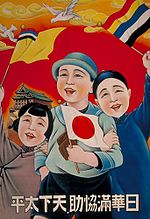 Propaganda poster promoting harmony between Japanese, Chinese, and Manchu. The caption says (Right to left): "With the cooperation of Japan, China, and Manchukuo, the world can be in peace."
Propaganda poster promoting harmony between Japanese, Chinese, and Manchu. The caption says (Right to left): "With the cooperation of Japan, China, and Manchukuo, the world can be in peace." Main article: Politics of Manchukuo
Main article: Politics of ManchukuoHistorians generally consider Manchukuo a puppet state of Imperial Japan[9] because of the Japanese military's strong presence and strict control of the government administration. Chinese historians generally refer to the state as 'Wei Manzhouguo' ('illegal Manchukuo'). Some historians see Manchukuo as an effort at building a glorified Japanese state in mainland Asia that deteriorated due to the pressures of war.[10]
The independence of Manchuria was proclaimed on 18 February 1932, and renamed to Manchukuo. The Japanese military commander appointed Puyi as regent (reign name Datong) for the time being and would become Emperor of Manchukuo but that he could not reign using the title of Emperor of China. Manchukuo was proclaimed a monarchy on 1 March 1934, with Puyi assuming the throne under the reign name of Emperor Kang-de. Puyi was assisted in his executive duties by a Privy Council (参議府), and a General Affairs State Council (国務院). This State Council was the center of political power, and consisted of several cabinet ministers, each assisted by a Japanese vice-minister.
The commanding officer of the Kwantung Army in Manchukuo was additionally Japanese ambassador to Manchukuo. He functioned in a manner similar to that of a British resident officer in British overseas protectorates, with the power to veto decisions by the emperor. The Kwangtung Army leadership placed Japanese vice ministers in his cabinet, while all Chinese advisors gradually resigned or were dismissed.
The Legislative Council (立法院) was largely a ceremonial body, existing to rubber-stamp decisions issued by the State Council. The only authorized political party was the government-sponsored Concordia Association, although various émigré groups were permitted their own political associations.
When the Japanese surrender was announced on 15 August 1945, Puyi was "asked" to abdicate, which he did.
Manchukuo 1932–1945 Personal Names Period of Reigns Era names (年號) and their corresponding range of years All given names in bold. Aisin-Gioro Puyi 愛新覺羅溥儀 Àixīnjuéluó Pǔyì March 1932 – August 1945 Datong (大同 Dàtóng) 1932–1934
Kangde (康德 Kāngdé) 1934–1945Administrative division of Manchukuo
- See List of administrative divisions of Manchukuo for a complete list of prefecture-level divisions.
During its short-lived existence, Manchukuo was divided into between five (in 1932) and 19 (in 1941) provinces, one special ward of Peiman (Japanese: 北満特別区) and two Special cities which were Hsinking (Japanese: 新京特別市) and Harbin (Japanese: 哈爾浜特別市). Each province was divided into between four (Hsingan-tung) and 24 (Fengtien) prefectures. Peiman lasted less than 3 years (1 July 1933 – 1 January 1936) and Harbin was later incorporated into Binkiang province. Lungkiang also existed as a province in the 1932 before being divided into Heiho, Lungkiang and Sankiang in 1934. Antung and Chinchow provinces separated themselves from Fengtien while Binkiang and Chientao from Kirin separated themselves in the same year.
Demographics
In 1908, the number of residents was 15,834,000, which rose to 30,000,000 in 1931 and 43,000,000 for the Manchukuo state. The population balance remained 123 men to 100 women and the total number in 1941 was 50,000,000.
In early 1934, the total population of Manchukuo was estimated as 30,880,000, with 6.1 persons the average family, and 122 men for each 100 women. These numbers included 29,510,000 Han Chinese, 590,760 Japanese, 680,000 Koreans, and 98,431 of other nationality White Russians, Mongols, etc. Around 80% of the population was rural. Other statistics indicate that in Manchukuo the population rose by 18,000,000.
From Japanese sources come these numbers: in 1940 the total population in Manchukuo of Lungkiang, Jehol, Kirin, Liaoning (Fengtien) and Hsingan provinces at 43,233,954; or an Interior Ministry figure of 31,008,600. Another figure of the period estimated the total population as 36,933,000 residents.
Around the same time the Soviet Union was advocating the Siberian Jewish Autonomous Oblast across the Manchukuo-Soviet border, some Japanese officials investigated a plan (known as the Fugu Plan) to attract Jewish refugees to Manchukuo as part of their colonisation efforts which was never adopted as official policy.
Population of main cities
- Yingkow or Yingkou or Newchwang (119,000 or 180,871 in 1940)
- Mukden or Shenyang (339,000 or 1,135,801 in 1940)
- Hsinking or Changchun (126,000 or 544,202 in 1940)
- Harbin (405,000 or 661,948 in 1940)
- Dairen or Dalian (400,000 or 555,562 in 1939)
- Antung or Dandong (92,000 or 315,242 in 1940)
- Kirin or Jilin (119,000 or 173,624 in 1940)
- Tsitsihar or Qiqihar (75,000 in 1940)
Japanese population
In 1931–2, there were 100,000 Japanese farmers; other sources mention 590,760 Japanese inhabitants. Other figures for Manchukuo speak of a Japanese population 240,000 strong, later growing to 837,000. In Hsinking, they made up 25% of the population. The Japanese government had official plans projecting the emigration of 5 million Japanese to Manchukuo between 1936 and 1956. Between 1938 and 1942 a batch of young farmers of 200,000 arrived in Manchukuo; joining this group after 1936 were 20,000 complete families. When Japan lost sea and air control of the Yellow Sea, this migration stopped.
When the Red Army invaded Manchukuo, they captured 850,000 Japanese settlers. With the exception of some civil servants and soldiers, these were repatriated to Japan in 1946–7. Many Japanese orphans in China were left behind in the confusion by then Japanese government and were adopted by Chinese families. Many, however, integrated well into Chinese society. In the 1980s Japan began to organise a repatriation programme for them but not all chose to go back to Japan.
Economy
Main article: Economy of ManchukuoManchukuo experienced rapid economic growth and progress in its social systems. Its industrial system was among the most advanced making it one of the industrial powerhouses in the region.[11] Manchukuo's steel production exceeded Japan's in the late 1930s. Many Manchurian cities were modernised during Manchukuo era. However, much of the country's economy was often subordinated to Japanese interests and, during the war, raw material flowed into Japan to support the war effort. Traditional lands were taken and redistributed to Japanese farmers with local farmers relocated and forced into collective farming units over smaller areas of land.
See also:
- Central Bank of Manchou
- Manchukuo yuan
- Manshukoku Hikoki Seizo KK
- Manshukoku Koku KK
- Showa Steel Works
- Manchurian Industrial Development Company
- Manchukuo Film Association
Transport
Main article: South Manchurian Railway CompanyManchukuo built an efficient and impressive railway system that still functions well today.
Military
Manchukuo Imperial Army
Main article: Manchukuo Imperial ArmyThe Manchukuo Imperial Army was the armed force of Manchukuo.
- Manchukuo Police Service
- Manchukuo Intelligence Agency
Manchukuo Imperial Guards
Main article: Manchukuo Imperial GuardsThe Manchukuo Imperial Guards was the elite unit of the Manchukuo armed forces created in 1933. It was charged with the protection of the Kangde Emperor Puyi, and senior members of the Manchukuo civil government. Its headquarters was in the capital of Hsinking, near the Imperial Palace in the centre of the city.
Main article: Manchukuo Imperial NavyThe Manchukuo Imperial Navy (Manshu Teikoku Kaigun) was the navy of the Japanese state of Manchukuo. As Manchukuo was a largely land-locked state, the leadership of the Japanese Kwantung Army regarded the development of a navy to have a very low military priority, although it was politically desirable to create at least a nominal force as a symbol of the legitimacy of the new regime.
Manchukuo Imperial Air Force
Main article: Manchukuo Imperial Air ForceThe Manchukuo Imperial Air Force (Dai Manshū Teikoku Kūgun) was established in February 1937, initially with 30 men selected from the Manchukuo Imperial Army and trained at the Japanese Kwantung Army aircraft arsenal in Harbin. The official air force's predecessor was the Manchukuo Air Transport Company (later re-named the Manchukuo National Airways) a paramilitary airline formed in 1931, which undertook transport and reconnaissance missions for the Japanese military.
War crimes in Manchukuo
Main article: War crimes in ManchukuoAccording to a joint study of historians Zhifen Ju, Mitsuyochi Himeta, Toru Kubo and Mark Peattie, more than 10 million Chinese civilians were mobilized by the Kwangtung Army for slave work in Manchukuo under the supervision of the Kōa-in.[12]
The Chinese slave laborers often suffered illness due to high-intensity manual labor. Some badly ill workers were directly pushed into mass graves in order to avoid the medical expenditure[13] and the world's most serious mine disaster, at Benxihu Colliery, happened in Manchukuo.
Bacteriological weapons were experimented on humans by the infamous unit 731 located near Harbin in Beinyinhe from 1932 to 1936 and to Pingfan until 1945. Victims, mostly Chinese, Russians and Koreans, were subjected to vivisection, sometimes without anesthesia.
Drug trafficking
In 2007, an article by Reiji Yoshida in the Japan Times argued that the Japanese investments were partly financed by selling drugs. According to the article, a document found by Yoshida shows that the Kōa-in was directly implicated in providing funds to drug dealers in China for the benefit of the puppet governments of Manchukuo, Nanjing and Mongolia.[14] This document corroborates evidence analyzed earlier by the Tokyo tribunal which stated that
Japan's real purpose in engaging drug traffic was far more sinister than even the debauchery of Chinese people. Japan, having signed and ratified the opium conventions, was bound not to engage in drug traffic, but she found in the alleged but false independence of Manchukuo a convenient opportunity to carry on a worldwide drug traffic and cast the guilt upon that puppet state.... In 1937, it was pointed out in the League of Nations that 90% of all illicit white drugs in the world were of Japanese origin...[15]
Education
Manchukuo developed an efficient public education system. The government established many schools and technical colleges, 12,000 primary schools in Manchukuo, 200 middle schools, 140 normal schools (for preparing teachers), and 50 technical and professional schools. In total the system had 600,000 children and young pupils and 25,000 teachers. Local Chinese children and Japanese children usually attended different schools, and the ones who did attend the same school were segregated by ethnicity, with the Japanese students assigned to better-equipped classes.
Confucius's teachings also played an important role in Manchukuo's public school education. In rural areas, students were trained to practice modern agricultural techniques to improve production. Education focused on practical work training for boys and domestic work for girls, all based on obedience to the "Kingly Way" and stressing loyalty to the Emperor. The regime used numerous festivals, sport events, and ceremonies to foster loyalty of citizens.[16] Eventually, Japanese became the official language in addition to the Chinese language taught in Manchukuo schools.
Stamps and postal history
Main article: Postage stamps and postal history of ManchukuoManchukuo issued postage stamps from 28 July 1932 until its dissolution following the final defeat of the Japanese Empire in August 1945. The last issue of Manchukuo was on 2 May 1945.
In popular culture
Bernardo Bertolucci's 1987 film, The Last Emperor, presented a controversial portrait of Manchukuo through the memories of Emperor Puyi, during his days as political prisoner in the People's Republic of China.
Haruki Murakami's 1995 novel The Wind-Up Bird Chronicle deals greatly with Manchukuo through the character of Lieutenant Mamiya. Mamiya recalls, in person and in correspondence, his time as an officer in the Kwangtung Army in Manchukuo. While the period covered in these recollections extends for many years, the focus is on the final year of the war and the Soviet invasion of Manchuria.
The 2008 South Korean western The Good, the Bad, the Weird is set in the desert wilderness of 1930s Manchuria.
Anthem
Main article: National Anthem of Manchukuo1933 Anthem
Traditional Chinese Pinyin English translation 天地內 有了新滿洲 Tiān dì nèi, yǒu liǎo xīn mǎnzhōu (Now) there is the new Manchuria on Earth, 新滿洲 便是新天地 Xīn mǎnzhōu, biàn shì xīn tiān dì and the new Manchuria is our new land. 頂天立地 無苦無憂 造成我國家 Dǐng tiān lì dì, wú kǔ wú yōu, zào chéng wǒ guójiā Let us make our country to be upright and free of sadness, 只有親愛竝無怨仇 Zhǐ yǒu qīn'ài bìng wú yuànchóu with only love and no hate. 人民三千萬 人民三千萬 Rénmín sān qiān wàn, rénmín sān qiān wàn Thirty million people, thirty million people, 縱加十倍也得自由 Zòng jiā shí bèi yě dé zìyóu at ten times more we should still be free. 重仁義 尚禮讓 使我身修 Zhòng rényì, shàng lǐràng, shǐ wǒ shēn xiū, With virtue and li, rectified am I; 家已齊 國已治 此外何求? Jiā yǐ qí, guó yǐ zhì, cǐwài hé qiú? with family in order and with the state well-ruled, there are nothing I want. 近之則與世界同化 Jìn zhī, zé yǔ shìjiè tónghuà For now, may we assimilate with the world; 遠之則與天地同流 Yuǎn zhī, zé yǔ tiāndì tóng liú for the future, may we follow the ways of the Heaven and Earth. 1942 Anthem
Traditional Chinese Pinyin English translation 神光開宇宙 表裏山河壯皇猷 Shén guāng kāi yǔzhòu, biǎolǐ shānhé zhuàng huáng yóu With the Universe created in God's Light, the vast land strengthens the Emperor's rule; 帝德之隆 巍巍蕩蕩莫與儔 Dì'dé zhī lóng wēiwēi dàngdàng mò yǔ chóu So full is His virtue, so wide that it is beyond compare 永受天祐兮 萬壽無疆薄海謳 Yǒng shòu tiān yòu xī, wànshòuwújiāng bó hǎi xú May He always receive divine guidance, with his years surpassing the sea; 仰贊天業兮 輝煌日月侔 Yǎng zàn tiān yè xī, huīhuáng rì yuè móu [Let us] worship the divine work, its glory equals the sun and moon. Japanese Hepburn romanization English translation 大御光 天地に充ち Ohomi-hikari ametsuchi ni michi Filling the world with Divine light, 帝徳は 隆く 崇し Teitoku wa takaku totoshi The Emperor's virtue is noble and worshipped. 豊栄の 万寿ことほぎ Toyosaka no banju kotohogi Let us salute him with long life and prosperity 天つ御業 仰ぎまつらむ Ametsumiwaza aogimatsuramu and we revere the Emperor's deeds See also
History of Manchuria Not based on timeline Early tribes Gojoseon Yan (state) Han Dynasty | Xiongnu Donghu | Wiman Joseon Wuhuan | Sushen | Buyeo | Okjeo Xianbei Cao Wei Jin Dynasty (265–420) Yuwen Former Yan Former Qin Later Yan Goguryeo Balhae (Bohai) Northern Yan Mohe | Shiwei Khitan | Kumo Xi Northern Wei Tang Dynasty Liao Dynasty Jin Dynasty (1115-1234) Yuan Dynasty Ming Dynasty Qing Dynasty Far Eastern Republic Green Ukraine Republic of China Soviet Union Manchukuo China (Northeast China) Russia (Russian Far East) - Battle of Khalkhin Gol
- Battle of Lake Khasan
- Collaborationist Chinese Army
- Evacuation of Manchukuo
- History of the Republic of China
- Kuomintang
- List of East Asian leaders in the Japanese sphere of influence (1931–1945)
- Marco Polo Bridge Incident
- Northeast Anti-Japanese United Army
- Mengkukuo
- Mukden Incident
- Nomonhan
- Soviet invasion of Manchuria
- Unit 731
References
- ^ Encyclopædia Britannica article on Manchukuo
- ^ [1]
- ^ Although the territories came under the jurisdiction of the Nationalist government before the Chinese Civil War came to its conclusion in 1949, the brief Soviet occupation helped trasform the region into a power base for the Chinese Communist troops led by Mao Zedong where the People's Liberation Army could resupply itself with Japanese equipments and gain strategic advantage against the Nationalist government headed by Chiang Kai-shek.
- ^ Reginald Fleming Johnston, p. 438.
- ^ Between World Wars
- ^ Nish, Ian Hill (2002), Japanese foreign policy in the interwar period, Westport, CT: Praeger, p. 95, ISBN 0275947912.
- ^ Lu, David John (2002), Agony of choice: Matsuoka Yōsuke and the rise and fall of the Japanese Empire, 1880-1946, Lanham, MD: Lexington Books, p. 83, ISBN 0739104586.
- ^ Borisov, O. (1977). The Soviet Union and the Manchurian Revolutionary Base (1945-1949). Moscow, Progress Publishers.
- ^ Columbia Encyclopedia article on Manchukuo
- ^ Doak, Kevin Michael (2004), "Review: Sovereignty and Authenticity: Manchukuo and the East Asian Modern by Prasenjit Duara", The Journal of Japanese Studies 30 (2): 502–507, ISSN 0095-6848, http://www.jstor.org/stable/25064511.
- ^ Prasenjit Duara. "The New Imperialism and the Post-Colonial Developmental State: Manchukuo in comparative perspective". http://www.japanfocus.org/-Prasenjit-Duara/1715. Retrieved 25 July 2010.
- ^ Ju, Zhifen (2002), Japan's atrocities of conscripting and abusing north China draftees after the outbreak of the Pacific war.
- ^ Municipal Government Information Office (2005), Repatriation of one million Japanese via Huludao, Beijing: China Intercontinental Press, p. 25, ISBN 7508507355.
- ^ Japan profited as opium dealer wartime China, http://search.japantimes.co.jp/cgi-bin/nn20070830f1.html
- ^ HyperWar: International Military Tribunal for the Far East [Chapter 5]
- ^ Japan Focus.
Sources
- Toshihiko Kishi. "Manchuria's Visual Media Empire (Manshukoku no Visual Media): Posters, Pictorial Post Cards, Postal Stamps", Tokyo: Yoshikawa Kobunkan, 10 June 2010. ISBN 9784642080361
- Reginald Fleming Johnston. "Twilight in the Forbidden City". Soul Care Publishing, 18 March 2008. ISBN 978-0-9680459-5-4.
External links
- Manchukuo Imperial Army
- Manchu Money Museum
- Education in Mongolia and Manchukuo
- Manchukuo Flags
- "On Macro-economic Statistics for Manchukuo" by Yuzo Yamamoto
- "Toshiro Matsumoto s research over Manchukuo"
- "Vaticano-Manchukuo no sirve de mea culpa" by Gianni Valente
- "Manchukuo National Anthem"
- JAPAN-MANCHOUKUO PROTOCOL
- "References over Manchukuo"
- Zionism and the Japanese East Asia Co-Prosperity Sphere
- Japanese references to Mantetsu Railway Company
- Mukden Incident photos
States and territories in the sphere of influence of the Empire of Japan during World War II Categories:- Former countries in East Asia
- States and territories established in 1932
- States and territories disestablished in 1945
- 1945 disestablishments
- Manchukuo
- Military history of China during World War II
- Japanese puppet states
- Short-lived states of World War II
- Second Sino-Japanese War
Wikimedia Foundation. 2010.

